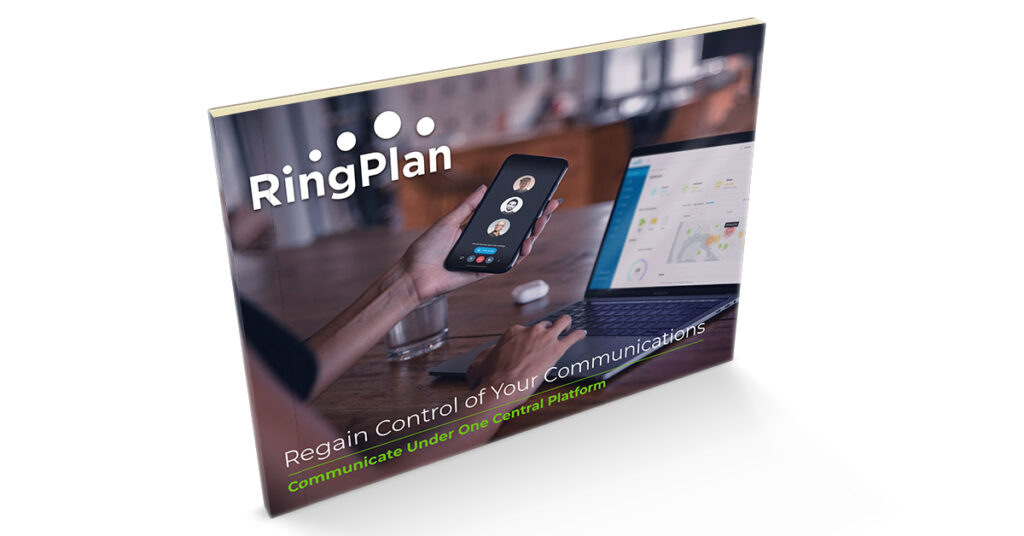Until recently, telemedicine, or the idea of communicating with patients remotely, seemed like a great idea but lacked public and political support to become fully adopted. Fast forward to today, and many prefer virtual, rather than traditional office visits.
The idea of using cross-communication platforms to conduct health visits seems obvious in today’s light. The evidence for telemedicine’s benefits during the pandemic is obvious. Officials from the Center for Disease Control (CDC) highlight telemedicine and its abilities in “expanding access to care, reducing disease exposure for staff and patients, preserving scarce supplies of personal protective equipment, and reducing patient demand on facilities” (Kooning).
We can see this today playing out on a regular basis, but it was not always this way. Before COVID-19, institutional changes took time to implement. Video conferencing software options like RingPlan Meet™ were not widely used as patients and providers were unlikely to stray from norms. (Kahn).
Learn the 5 Ways Telemedicine is Upending the Healthcare System
Download the White Paper

Where Was the Demand?
There’s no question that the COVID-19 Pandemic fast-tracked the implementation of cross-communication technologies in the health field. Before the pandemic, as far as 2016, the demand for telemedicine was not great, despite the clear benefits highlighted by medical professionals in studies researching telemedicine’s potential as it relates to neurosurgery (Kahn).
At the time, in 2016, the tools already existed. The technology that would allow patients to communicate with their doctors from home was readily available. Many hospitals had already fully implemented the technology into their processes, but behaviors remained the same.
Download the Presentation

What is at Fault, the Tools or the Tech?
With tools like video conferencing apps having been fully developed for some time. It’s easy to conclude that It was not the lack of tools that made telemedicine’s adoption slow. It was not the lack of technology or hardware. It was an atmosphere of compliance to the norm that made us slow to change (Kahn).
Adopting Telemedicine Required a Change in Behavior
The Pandemic forced us to adapt because it created the demand that was missing or growing too slowly in our society.
Demand and Supply
During the early stages of the pandemic, the CDC recorded a 154% increase of telehealth visits in the first quarter of 2020 compared to 2019. Most of these visits were a result of policy changes and not COVID-related visits. Although there was an increase in COVID-related visits from 5.5% to 16.2%, the majority of appointments were simply a result of hospitals adapting, and patient behaviors adapting to changes in policy brought about by our nation’s reaction to the pandemic (Kooning).
Schedule a Demo
The Status Quo Has Changed
As we continue through in this pandemic and beyond, we begin to see many of the foretold benefits of telemedicine but some concerns remain the same.
1. Compliance Concerns
The excessive speed at which society had to change during this time has led to a loosening of enforcements. During this time, the federal government loosened its restrictions on the application of telemedicine in the home. The DEA loosening restrictions on Doctors issuing online prescriptions to sick patients. The department of Health and Human Services temporarily waived HIPPA enforcement for the application of telehealth, allowing smaller practices with smaller infrastructure alternate ways to connect with patients (Weigel).
Will compliance standards return to normal when all is set and done and COVID is a long-gone memory? That might depend on what our society defines as ‘normal.’
Learn The 5 Ways Telemedicine is Upending the Healthcare System
Download the White Paper
2. Accessibility Concerns
Medical facilities are concerned with making sure all patients can be seen. Not all patients own a computer or have fast-speed internet. This may include the poor or even individuals in rural, hard-to-reach areas not serviced by local or regional providers. Others have medical incapacities which make it difficult to connect, let alone operate a computer. There are also those who, don’t know how to connect like the elderly who never adapted to changing times.
A recent publication in Telemedicine Journal and E-Health outlined seven factors that play a role in how older people view Home Telehealth Service (HTS). These included perceived usefulness, effort expectancy, social influence, perceived security, computer anxiety, facilitating conditions, and physicians’ opinion (Cimperman).
Get an Instant Price Quote
3. Security and Privacy Concerns
Security continues to be a major concern. Medical facilities search for secure and encrypted networks by which to communicate. IT Departments are busy looking for ways to protect the data they are entrusted with.
The concern is real as medical devices play a bigger role in our lives. Technology designed to transmit our data, photos, videos, and other health details can also give away information we prefer to keep private. Connected Devices in the home like cameras, microphones; and in the body like implanted medical sensors pose a threat to user privacy and will continue to do so until all threats are identified and addressed. A goal that is difficult to accomplish without a single comprehensive regulatory framework in place that can monitor and regulate all telehealth services; decisions that come from one federal regulation entity, an entity such as the Federal Trade Commission (Hall).
Learn how RingPlan protects video conference user privacy.
Schedule a Demo Below
Beyond Features, Beyond Price
Unlike many other professions, medical providers look beyond the typical features and price; their concern goes deeper than that. Their first goal is to ensure they can provide adequate care at an adequate time, while also doing their part to protect patient privacy and security.
Conclusion
The idea of using technology to virtually see a doctor no longer seems abstract. Furthermore, those with the means to connect may prefer it to traditional ways. These individuals are now benefiting from the positive effects of telemedicine. They have expanded their access to care, reduced disease exposure during the Pandemic, have helped preserve scarce supplies of personal protective equipment, and are reducing patient demand on facilities.
Interested in an Instant Price Quote?
Enter the Number of Users Below:
Citations:
Cimperman, M., BsC, Makovec Brenčič, M., PhD, Trkman, P., PhD, & Stanonik, M., MD. (2013, October). Older adults’ perceptions of home telehealth services. Retrieved January 13, 2021, from https://www.ncbi.nlm.nih.gov/pmc/articles/PMC3787386/
Hall, J. L., & McGraw, D. (2014, February 01). For Telehealth To Succeed, Privacy And Security Risks Must Be Identified And Addressed: Health Affairs Journal. Retrieved January 13, 2021, from https://www.healthaffairs.org/doi/full/10.1377/hlthaff.2013.0997
Kahn, E., Marca, F., & Mazzola, C. (2016, February 04). Neurosurgery and Telemedicine in the United States: Assessment of the Risks and Opportunities. Retrieved January 13, 2021, from https://www.sciencedirect.com/science/article/abs/pii/S1878875016001637
Koonin LM, Hoots B, Tsang CA, et al. Trends in the Use of Telehealth During the Emergence of the COVID-19 Pandemic — United States, January–March 2020. MMWR Morb Mortal Wkly Rep 2020;69:1595–1599. DOI: http://dx.doi.org/10.15585/mmwr.mm6943a3external icon.
Weigel, G., & Ramaswamy, A. (2020, May 13). Opportunities and Barriers for Telemedicine in the U.S. During the COVID-19 Emergency and Beyond. Retrieved January 13, 2021, from https://www.kff.org/womens-health-policy/issue-brief/opportunities-and-barriers-for-telemedicine-in-the-u-s-during-the-covid-19-emergency-and-beyond/

